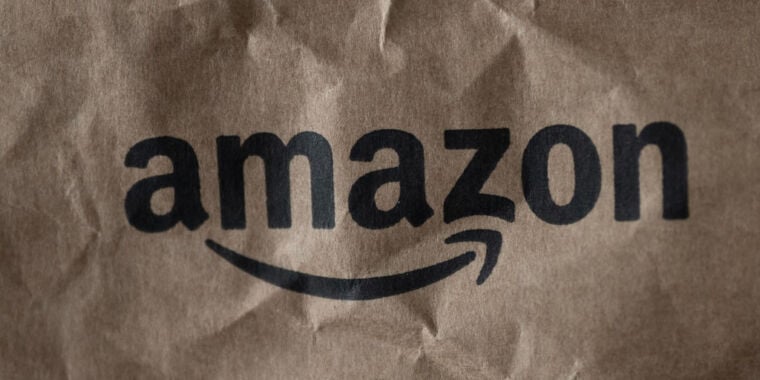Amazon failed to adequately alert more than 300,000 customers to serious risks—including death and electrocution—that US Consumer Product Safety Commission (CPSC) testing found with more than 400,000 products that third parties sold on its platform.
The CPSC unanimously voted to hold Amazon legally responsible for third-party sellers’ defective products. Now, Amazon must make a CPSC-approved plan to properly recall the dangerous products—including highly flammable children’s pajamas, faulty carbon monoxide detectors, and unsafe hair dryers that could cause electrocution—which the CPSC fears may still be widely used in homes across America.
While Amazon scrambles to devise a plan, the CPSC summarized the ongoing risks to consumers:
If the [products] remain in consumers’ possession, children will continue to wear sleepwear garments that could ignite and result in injury or death; consumers will unwittingly rely on defective [carbon monoxide] detectors that will never alert them to the presence of deadly carbon monoxide in their homes; and consumers will use the hair dryers they purchased, which lack immersion protection, in the bathroom near water, leaving them vulnerable to electrocution.
Instead of recalling the products, which were sold between 2018 and 2021, Amazon sent messages to customers that the CPSC said “downplayed the severity” of hazards.
In these messages—“despite conclusive testing that the products were hazardous” by the CPSC—Amazon only warned customers that the products “may fail” to meet federal safety standards and only “potentially” posed risks of “burn injuries to children,” “electric shock,” or “exposure to potentially dangerous levels of carbon monoxide.”
Typically, a distributor would be required to specifically use the word “recall” in the subject line of these kinds of messages, but Amazon dodged using that language entirely. Instead, Amazon opted to use much less alarming subject lines that said, “Attention: Important safety notice about your past Amazon order” or “Important safety notice about your past Amazon order.”
Amazon then left it up to customers to destroy products and explicitly discouraged them from making returns. The e-commerce giant also gave every affected customer a gift card without requiring proof of destruction or adequately providing public notice or informing customers of actual hazards, as can be required by law to ensure public safety.
Further, Amazon’s messages did not include photos of the defective products, as required by law, and provided no way for customers to respond. The commission found that Amazon “made no effort” to track how many items were destroyed or even do the minimum of monitoring the “number of messages that were opened.”
we went from the amazon is burning to i am burning because of amazon
🎵 It’s the ciiiircle of liiiiiife… 🎵
Rossmann did a review a few months ago of electrical fuses on Amazon. Very few of these electrical safety devices worked as advertised.
Yup and the all negative reviews are inexplicably removed.
If any physical store got a dangerous product, was made undeniably aware of the danger and continued to sell the product - they’d be in a lot of trouble.
Likely more than just removed. I’m pretty sure that I left one too many scathing reviews of products that were defective by design or outright frauds, now I can’t leave any reviews.
Oh i can explain.
I straight up wouldn’t trust Amazon for any electrical safety device. Go to a hardware store or parts distributor.
Even a surge protector from a reputable brand could be suspect - Amazon lets counterfeit products on the storefront all the time, and most sellers barely list any specifications on product pages.
Just do not buy random non brand stuff? A Fluke multimeter will work the same regardless where you buy it.
Counterfeits apply to all stores. The local store in no way has the capability or knowledge to identify them. On Amazon I could at least get reviews to tell me about it.
In any case, testing is better than believing, regardless of anything else.
Local stores are more likely to get their product from reputable suppliers (yes, this varies) - on Amazon, you’re buying from whoever unless you specifically seek out an official store, if it exists. Also, Fluke has been posting about counterfeits for years; here is a post from 6 months ago, which would suggest it’s an ongoing issue.
Here is a 2021 post from Electrician Talk about electricians receiving multimeters that don’t ohm out correctly (kind of a big fucking deal). Additionally, if you buy products on Amazon from an unauthorized seller, even if the product works fine the warranty is generally void.
Edit: Also, to be pedantic, a multimeter isn’t an electrical safety device; I’m using that term to refer to protective devices like fuses, GFCIs, AFCIs, breakers, thermal overloads, etc.
*car fuses. But yeah, I don’t wanna be burned inside a car.
Its still an electrical fuse regardless of whether it goes into a car or a plug
deleted by creator
deleted by creator
I’m not racist… BUT… I will not buy any product until I thoroughly look through the item description, seller profile, and determine that the seller is not a secret shop from some place in China. It’s so quickly slapped together and much of the time, terrible products. I get it. It’s Chinese and they go after speed over quality, but like… Anytime I’ve ever had an issue, the seller was always based in China.
This is true, but also on the flip side, if you find your Nintendo DS Lite from almost 2 decades ago, and look at it, and the battery hasn’t turned spicy yet and you look on the battery and see it was made in China… it’s pretty impressive.
The cheap shit on Amazon however, yeah I wouldn’t trust it tbh.
It’s about who sets the quality control standards. Somebody experienced who cares, or nobody at all? Amazon doesn’t enforce safety.
My DSi’s battery swelled up and nearly exploded less than a decade after getting it. Still have the DSi, but no battery.
I have my PSP 2000, PSP 3000, DSLite, DSi, DSi XL, 3DS XL, and New 3DS XL.
Out of all of those devices, the only ones with bad batteries that were spicy were the PSP 2000, PSP 3000, and 3DS XL. The New 3DS XL was off since 2020 and still had half charge when I powered it on again in 2024, guess I left it fully charged, oops.
How did the battery nearly explode for you? Even with my PSP batteries that were so badly swollen they actually cracked the plastic shell of the battery, I still think they weren’t near exploding. Did you charge it while it was super swollen or something?
I think I just used the hell out of it as a kid. That DSi got me through a lot of fights between my parents, constant extended road trips, and lack of anything else to do. It swole up so much the battery panel nearly snapped right off and is permanently bent. I still kept using it til it couldn’t hold a charge, because I was a kid and didn’t realize the risk of doing so.
Ouch! That is scary haha I totally would have done the same though. I’m glad I know better now and I make sure to inspect my devices to make sure the battery looks to be good still.
It’s not about where it’s manufactured as much as it is about who wanted it manufactured. If it’s from a company that cares about its brand image like Anker, then you’re probably going to get a good product
To play China’s advocate for a sec… Could this also be a symptom of America’s new alpha sigma trend of drop shipping?
Only time I ever trust them is when it’s a verified shop from a highly reputable company like Seagate, but even then I don’t trust Amazon.
Worst thing about buying a budget phone, like I’ve done for my past 3 phones, is that phone stores never have good cases and the only place to find good (as in my phone won’t be destroyed when dropped, case isn’t slippery, and case won’t be destroyed in a week) is Amazon. So I’ve been essentially locked into buying cheap Chinese phone cases there because lack of options for anything that isn’t the newest flagship phone model.
No idea which phone you have, but dbrand does carry a decent amount of models. However, it is mostly limited to Apple, Google, Samsung, and One Plus. It does suck trying to find some things though. I do try to get things directly from the manufacturer website when it makes sense, but sometimes Amazon IS their website.
If I didn’t already have a case, I’d have to look into this more.
Yeah thats how I am, I only buy books from Amazon at this point and even then I use a link from their site or whatever. Also for quick context if you want a manga or light novel from Yen On their website has links for all sellers.
Can’t wait for them to be hit with their 0.1% fine.
As is tradition.
The issue isn’t the fine. Amazon is breaking numerous federal laws by not managing what is being shipped by 3rd party sellers. They are violating several FAA regulations on thousands of packages daily. At some point they will have to put a plan in place to vet these packages and that will be EXTREMELY costly. We will see a dramatic shift in how Amazon does business in the near future.
Is it more costly than buying a senator or two? Cause I bet we’ll NOT see any major changes that could cost them real money.
It doesn’t matter what senators they have, if the FAA/TSA revoke their license to ship using air services they will lose billions.
Are you sure about that though? Do you really think they will be held accountable?
I don’t think they will be held accountable, they will be hit with a 0.1% fine, even if there are many deaths, and they will move on with their lives.
As is tradition.
When I was a kid I thought that clearly understandable things (punishment is intended to prevent doing something again, that is, to clearly undo the benefit for the criminal ; best of all be worth twice that benefit ; if not, then those issuing punishment are clearly corrupt, and the punishment should be reconsidered, and they should be removed from power and investigated ; and so on through all the chain) not being met will be seen and violently protested, but later I learned what gaslighting is!
Say, legalism is gaslighting. As in “you should fight evil only by the law which is made by that evil, and you should only consider that law not a law when you’ve managed to remove it by the rules made by evil”.
Any other thing which says “things are normal, no need to break stuff, everybody thinks it’s normal, you should too” is gaslighting.
We are a whole civilization gaslighted by parasites into not crushing them.
Where is the list of products? It’s gotta be online somewhere.
See that is the real issue here. They did not recall them. They did not list them. They did not it seems stop selling them.
The suit seems to be about the fact they did not do what they where supposed to. This is the time when we get to see if our governments have any ability to govern anymore.
That’s insane. I have some old Amazon basics surge protectors… I guess I need to assume they are a risk.
I stopped buying this sort of thing a decade or so ago, but I don’t see a date here…
I guess none of us should trust any of their products if they aren’t going to tell us which ones are dangerous.
i came in here to find out the same thing.
There needs to be some serious fines for amazon when they fail to recall and remove unsafe products.
How about bathing the fucking turd Bezos with twenty faulty hairdryers that they failed to recall?
He’s not CEO any more. Andy Jassy is.
Okay, do it to them both. They’re both complicit.
Electrocute both then.
The e-commerce giant also gave every affected customer a gift card without requiring proof of destruction or adequately providing public notice or informing customers of actual hazards, as can be required by law to ensure public safety.
I was supposed to get a gift card?? I didn’t get a freakin gift card, I have to destroy it and submit a bunch of evidence to the manufacturer to get a refund.
I know cheep electronics are fun but please buy UL Listed stuff
Tons of stuff on Amazon just print fake UL listing logos and numbers.
Given that there appear to be plenty of overseas sellers that will happily counterfeit a UL stamp, or copy an entire product - including UL stamp - but with different innards, how would we even know at this point?
UL aggressively performs market surveys to catch this kind of stuff
Which worked with physical stores but with Amazon where you have 100+ sellers hawking the same defective PoS under 100+ unpronouncable brand-names
Which means don’t buy electronics on Amazon because you can’t usually tell from the listing and if it is, it could just be counterfeit.
Kind of reminds me of the Roman empire falling due to the fact that too many lead based products were made.
Deep breath
Nitpick: Electrocution is killing, by definition. (Perhaps they meant shock?)
Edit for those who don’t know: It’s a contraction of electric and execution.
It’s not a nitpick to know the meaning of the words we use, and how to use them. [email protected] and the arstechnica editors should know better.
It annoyed me too for a while but it’s changing. I can’t find a definitive source, but I’ve seen a quote from MW from 2015 which had the original meaning. Now it includes “severely injure”.
Wheatley: “A very minor case of serious brain damage.”
Try using mathematical triangle recursive algorithms in geometric Octave code to protect against them. Don’t approach unusual electronics in general at this time.
Maybe unpopular opinion, but I’m on the fence about this. I slightly subscribe to the conspiracy theory that many “certified” products are just ways to stifle competition while also justifying higher prices for “certified” products.
Take UL listed electronics for example. Sure, that might mean something on a full computer full of electronics, but a lamp is two fucking wires and a bulb. It’s not complicated. Even confirming proper metals are used to prevent shrinking and expansion is not complicated. But the same $15 lamp is $100 once it’s UL certified. The math doesn’t add up.
Like I said: On the fence. Maybe it’s the best way to ensure safe products, but it also seems like a great system for lining specific peoples pockets.
EDIT: Jesus people, read my post before you get all triggered. I’m not saying shit products don’t exist.
You clearly haven’t seen how bad “no-consequences cheap” can be with even simple electronics. Your lamp, for example:
Melting (under-spec or poor construction) AC wiring, poor material for the cord, switch or socket.
Melting / burning lampshade (yes, even with LEDs).
Electrocution risk - Loose connections, easily broken plug or lamp socket, switch, inappropriate (conductive) materials.**
And that’s not even considering larger-design problems - Lamps that are prone to falling over (and breaking, or melting other things), lamps that flex but not too much or they break exposing problems above, assemblies that aren’t reasonably child-proof, RF interference even.
The race to the bottom without rules is a dangerous place for the consumer expecting a bare minimum guarantee of fitness while inviting these products into their home, not to mention those most often buying the cheapest option may be the most vulnerable.
Dear Mr. High & Mighty, I’ve actually seen all those things - on UL certified devices.
But again, not my point. My point was a lamp isn’t complicated enough for the UL to charge so much that the price goes up 10x. If they are charging that much, there should be tons of competitors trying to get a piece of that pie. If they aren’t charging alot, then many of the products on Amazon, that are often certified by authorities in other countries, would also get UL certified. It has all the hallmarks of a racket.
I see you learned your discussion skills from the Donald Trump School of Bullshiting.
You mean by people disagreeing with me on points I never made?
LOL
but a lamp is two fucking wires and a bulb. It’s not complicated.
And yet, companies can and will cut corners whenever they can. Using too thin of wire or the wrong type of plastic can cause a fire. Cheap switches, bad insulators for the bulb socket are also things that they’ll cut corners on.
That’s not really the point I was going for. I’m not saying bad companies won’t make shit products. I’m just pointing out a lamp doesn’t require alot of effort for the UL to certify, so it can’t justify a 10x increase in cost. But they must be charging a ton or more companies would just get their products certified.
I don’t know where you’re getting the idea that UL certified goods are super expensive. UL is the bare minimum. I have a $10 UL certified lamp on my desk right now. Certifications like TUV and similar are the more expensive ones.
UL certification can mean different things, depending on the product and type of mark. It also isn’t that expensive to get UL listed as it isn’t like every single item you produce is tested. Each product you design is tested, but not each item you produce.
There are 3/4 types. UL listed, UL recognized, and UL classified. Certified is newer and more stringent.
- Recognized is mostly for machinery and components within machinery. It isn’t terribly difficult to get, but annoying. I have dealt with this type as we design and build electrical panels. Usually you hand the design to a panel builder and they will get it certified before delivery.
- Listed is for products and appliances, and is fully tested for safety. This applies to most consumer electronics.
- Certified Enhanced is also for products, and you can read up on it here: https://www.ul.com/news/qa-uls-enhanced-certification-mark
- Classified is for products and is half ass tested. All it means is that some requirements for UL were tested and passed, but not all.
If a product is Classified by UL, this can mean its testing meets the particular requirements for a single test with a published result, but has nothing to do with all the other tests that may form part of a Standard (i.e., UL 181).
As for pricing for UL listed, it can be just a few grand for a single product. Not much when you are selling thousands. I am sure Classified is even cheaper. I wonder how many of these cheap ass lamps say Classified.














